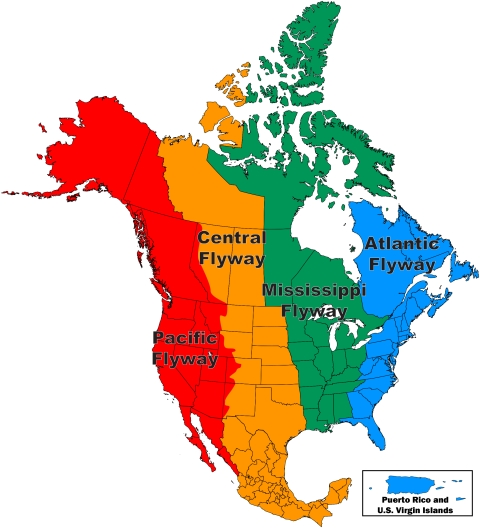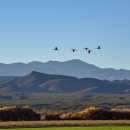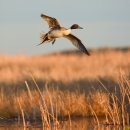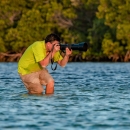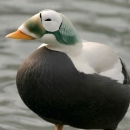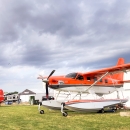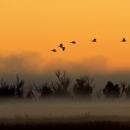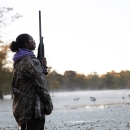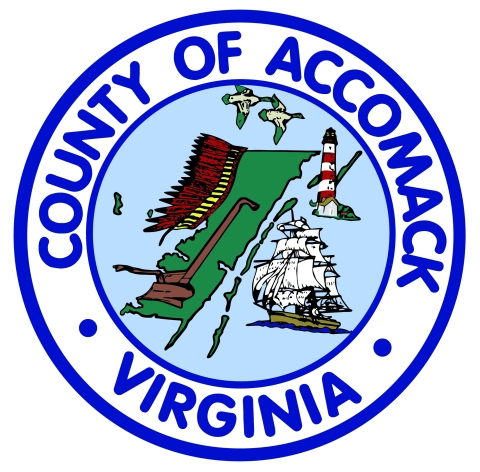The U.S. Fish & Wildlife Service (USFWS) and its partners manage migratory birds based largely on routes the birds follow as they migrate between nesting and wintering areas.
Based on those routes, four administrative Flyways (Atlantic, Mississippi, Central and Pacific) were established in North America to facilitate management of migratory birds and their habitats. Each flyway has a Council, consisting of representatives from each state, provincial, and territorial agency within that Flyway. The Councils are advised by Flyway technical committees consisting of biological staff from their member agencies. The technical committees evaluate population and habitat information and make recommendations to the Councils on matters of migratory bird conservation.
The Atlantic, Mississippi, and Pacific Flyways each have a USFWS Flyway Representative and assistant who work with the Flyway Council and their technical committees to share information and develop management recommendations. The Central Flyway has only a Flyway Representative who performs those functions.
To obtain more information about each flyway, please visit the links below.
Shape files and other data (for GIS applications) that are associated with the Flyway Boundaries map.
Atlantic Flyway
The Atlantic Flyway Council is composed of the states of Connecticut, Delaware, Florida, Georgia, Maine, Maryland, Massachusetts, New Hampshire, New Jersey, New York, North Carolina, Pennsylvania, Rhode Island, South Carolina, Vermont, Virginia, and West Virginia; the Canadian territory of Nunavut and provinces of Newfoundland, New Brunswick, Nova Scotia, Ontario, Prince Edward Island, and Quebec; plus the U.S. territories of Puerto Rico and U.S. Virgin Islands.
The Atlantic Flyway Council contains representatives (usually administrators) from all the agencies that have management responsibility for migratory bird resources in the Flyway.
The Council determines actions required for sound migratory game bird management and makes recommendations to the U.S. Fish and Wildlife Service.
For more information about the Atlantic Flyway Council or Tech Sections, please contact the USFWS' Atlantic Flyway Representative, Pat Devers.
Upcoming Meetings/Events of Interest
Data Book
Mississippi Flyway
Administratively, the Mississippi Flyway is composed of the states of Alabama, Arkansas, Indiana, Illinois, Iowa, Kentucky, Louisiana, Michigan, Minnesota, Mississippi, Missouri, Ohio, Tennessee, and Wisconsin, and the Canadian provinces of Saskatchewan, Manitoba and Ontario.
The Mississippi Flyway Council was organized in 1952 and contains representatives (usually agency administrators) from these state agencies (and often provincial representatives from Saskatchewan, Manitoba, and Ontario) that have management responsibility for migratory bird resources in the Flyway. The Council was established to coordinate the management of migratory game birds in the Mississippi Flyway and to promote those activities of its members that serve the long-term benefit to the resources and the flyway as a whole. In addition, the Council provides a point of contact for the Fish and Wildlife Service for the purpose of coordinating federal/state/provincial management activities, providing advice to the Service on long-term and short-term migratory bird management needs of the flyway - including the establishment of harvest regulations so that the welfare of these resources can be properly safeguarded.
The Mississippi Flyway Council Technical Section was established to provide technical expertise and advice to the Council to ensure biologically-based management of migratory game birds. The MFC Technical Section is a forum for cooperative interaction among state, provincial, territorial, tribal, university, conservation-organization and federal biologists, with the goal of implementing integrated management and research programs for migratory game birds.
For more information about the Mississippi Flyway Council or Tech Sections, please contact the USFWS' Mississippi Flyway Representative, Dave Scott.
Upcoming Meetings/Events of Interest
Data Book
Central Flyway
The Central Flyway was formed in 1948 and is composed of the states of Montana, Wyoming, Colorado, New Mexico, Texas, Oklahoma, Kansas, Nebraska, South Dakota, and North Dakota, and the Canadian provinces of Alberta, Saskatchewan and the Northwest Territories.
The Central Flyway Council consists of representatives (usually agency administrators) from their respective state, provincial, or territorial wildlife agencies that have management responsibility for migratory bird resources in the Flyway.
Central Flyway Council mission: To provide leadership in the international conservation of migratory game birds and build partnerships among public and private groups interested in this valuable wildlife resource.
Three technical committees serve and advise the Council: one deals with waterfowl, one with migratory shore and upland game birds (e.g., doves, rails, and cranes), and the third deals with migratory nongame bird issues. Each group has meetings each year to share information regarding ongoing research, monitoring, and management issues about migratory game birds.
The Council, in concert with the Technical Committees, determines actions required for sound migratory game bird management and makes recommendations to the U.S. Fish and Wildlife Service.
For more information about the Central Flyway Council or Tech Sections, visit the council website directly below or contact the USFWS' Central Flyway Representative, Tom Cooper.
Upcoming Meetings/Events of Interest
Central Flyway Council Website
Data Book
Midwinter Survey Report
Pacific Flyway
The Pacific Flyway Council is an administrative body that forges cooperation among public wildlife agencies for the purpose of protecting and conserving migratory birds in western North America. The Council is composed of the director or an appointee from the public wildlife agency in each state and province in the western United States, Canada, and Mexico.
U.S. members of the Pacific Flyway Council include Alaska, Arizona, California, Idaho, Nevada, Oregon, Utah, Washington, and those portions of Colorado, Montana, New Mexico, and Wyoming west of the Continental Divide.
The federal governments of the United States, Canada, and Mexico, and Alaska subsistence harvest management bodies may provide an ex officio representative to the Council. Only U.S. state members vote on U.S. regulatory matters.
The Council has responsibilities in the annual process of setting migratory bird policy and regulations within the United States, and conducts and contributes to migratory bird research and management throughout the United States, Canada, and Mexico.
The Council is given biological advice by both a game and a nongame migratory bird technical committee. These committees are each composed of one biologist from the public wildlife agency in each state and province in the western United States, Canada, and Mexico.
For more information about the Pacific Flyway Council or Tech Sections, please visit the council website directly below or contact the USFWS' Pacific Flyway Representative, Todd Sanders.
Pacific Flyway Council Website
Upcoming Meetings/Events of Interest
Data Book
National FWS Programs They Work With
Related Stories
Partner Category
Partnership Services
Through our partnerships we are able to expand our capabilities through the inclusion of services in areas such as:
- Grant opportunities
- Sponsorship of grants
- Cooperative Agreements
To find out more about how our partner provides services view our partner services below.
